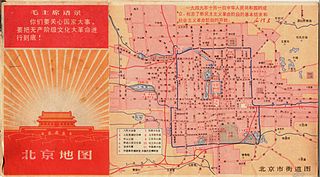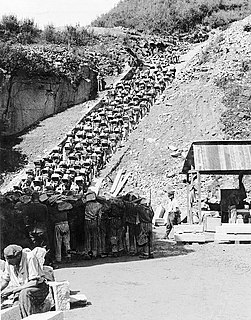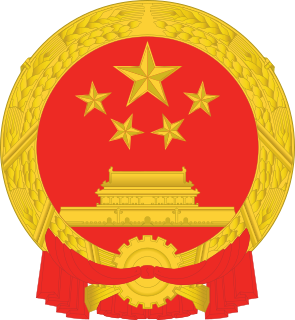Related Research Articles

Deng Xiaoping was a Chinese politician who was the paramount leader of the People's Republic of China from 1978 until 1989. After Chairman Mao Zedong's death in 1976, Deng gradually rose to power and led China through a series of far-reaching market-economy reforms, which earned him the reputation as the "Architect of Modern China".

Mao Zedong, also known as Chairman Mao, was a Chinese communist revolutionary who became the founding father of the People's Republic of China (PRC), which he ruled as the chairman of the Communist Party of China from its establishment in 1949 until his death in 1976. Ideologically a Marxist–Leninist, his theories, military strategies, and political policies are collectively known as Maoism.

The Tiananmen Square protests or the Tiananmen Square Incident, commonly known as the June Fourth Incident in mainland China, were student-led demonstrations held in Tiananmen Square in Beijing during 1989. The popular national movement inspired by the Beijing protests is sometimes called the '89 Democracy Movement. The protests started on April 15 and were forcibly suppressed on June 4 when the government declared martial law and sent the People's Liberation Army to occupy central parts of Beijing.

The Cultural Revolution, formally the Great Proletarian Cultural Revolution, was a sociopolitical movement in China from 1966 until 1976. Launched by Mao Zedong, Chairman of the Communist Party of China, its stated goal was to preserve Chinese Communism by purging remnants of capitalist and traditional elements from Chinese society, and to re-impose Mao Zedong Thought as the dominant ideology in the CCP. The Revolution marked Mao's return to the central position of power in China after a period of less radical leadership to recover from the failures of the Great Leap Forward, which led to approximately 30 million deaths in the Great Chinese Famine only five years prior.

The Four Olds or the Four Old Things was a term used during the Cultural Revolution by the Red Guards in the People's Republic of China in reference to the pre-communist elements of Chinese culture they attempted to destroy. The Four Olds were: Old Customs, Old Culture, Old Habits, and Old Ideas. The campaign to destroy the Four Olds began in Beijing on August 19, 1966, shortly after the launch of the Cultural Revolution.

The Black Book of Communism: Crimes, Terror, Repression is a 1997 book by Stéphane Courtois, Andrzej Paczkowski, Nicolas Werth and several other European academics documenting a history of political repression by Communist states, including genocides, extrajudicial executions, deportations, killing populations in labor camps and artificially-created famines. The book was originally published in France as Le Livre noir du communisme: Crimes, terreur, répression by Éditions Robert Laffont. In the United States, it was published by Harvard University Press, with a foreword by Martin Malia. The German edition, published by Piper Verlag, includes a chapter written by Joachim Gauck. The introduction was written by Courtois. Historian François Furet was originally slated to write the introduction, but he was prevented from doing so by his death.

Stéphane Courtois is a French historian and university professor, a Director of research at the French National Centre for Scientific Research (CNRS), Professor at the Catholic Institute of Higher Studies (ICES) in La Roche-sur-Yon, and Director of a collection specialized in the history of communist movements and regimes.

The Yan'an Rectification Movement, also known as Zhengfeng or Cheng Feng, was the first ideological mass movement initiated by the Chinese Communist Party (CCP), going from 1942 to 1945. The movement took place at the communist base at Yan'an, a remote and isolated mountainous area in northern Shaanxi, after the communists' Long March. Though it was during the Second Sino-Japanese War, the CCP was experiencing a time of relative peace when they could focus on internal affairs.

Decossackization was the Bolshevik policy of systematic repressions against Cossacks of the Russian Empire, especially of the Don and the Kuban, between 1917 and 1933 aimed at the elimination of the Cossacks as a separate ethnic, political, and economic entity. This was the first example of Soviet leaders deciding to "eliminate, exterminate, and deport the population of a whole territory," which they had taken to calling the "Soviet Vendée" The decossackization is frequently described as a genocide of the Cossacks, a process described by scholar Peter Holquist as part of a "ruthless" and "radical attempt to eliminate undesirable social groups" that showed the Soviet regime's "dedication to social engineering".

Extermination through labour was the practice in concentration camps in Nazi Germany of killing prisoners by means of forced labour.

Chen Xitong was a member of the Politburo of the Communist Party of China and the Mayor of Beijing until he was removed from office on charges of corruption in 1995.
The Pitchfork Uprising of 1920, also known as Black Eagle Uprising, was a peasant uprising against the Soviet policy of the war communism in what is today Eastern Tatarstan and Western Bashkortostan. It started in the village of Yanga Yelan, Menzelinsky Uyezd, Ufa Governorate on February 4, 1920, where local peasants tried to resist confiscation of their food. When they refused to give up their produce, the leader of the military confiscation unit ("prodotryad") arrested some of them. Peasants asked him to free the hostages, but he refused. Peasants killed the members of prodotryad and circulated the appeal to rise.
Scar literature or literature of the wounded is a genre of Chinese literature which emerged in the late 1970s during the "Boluan Fanzheng" period, soon after the death of Mao Zedong, portraying the sufferings of cadres and intellectuals during the tragic experiences of the Cultural Revolution and the rule of the Gang of Four.

Dekulakization was the Soviet campaign of political repressions, including arrests, deportations, and executions of millions of kulaks and their families in the 1929–1932 period of the first five-year plan. To facilitate the expropriations of farmland, the Soviet government portrayed kulaks as class enemies of the USSR.

The Campaign to Suppress Counterrevolutionaries was the first political campaign launched by the People's Republic of China designed to eradicate opposition elements, especially former Kuomintang (KMT) functionaries accused of trying to undermine the new Communist government. It began in March 1950 when the Chinese Communist central committee issued the Directive on elimination of bandits and establishment of revolutionary new order, and ended in 1953.

The Sufan movement was a political campaign against political opponents in the People's Republic of China under Mao Zedong. The term "sufan" is short for "肅清暗藏的反革命分子", and can roughly be taken as referring to a 'purge' of hidden counterrevolutionaries. Mao directed 5 percent of counter-revolutionaries to be eliminated. The Sufan movement lasted from July 1955 to late 1957, during which 214,000 people were arrested and approximately 53,000 died.
Many mass killings occurred under 20th-century communist regimes. Death estimates vary widely, depending on the definitions of deaths included. The higher estimates of mass killings account for crimes against civilians by governments, including executions, destruction of population through man-made hunger and deaths during forced deportations, imprisonment and through forced labor. Terms used to define these killings include "mass killing", "democide", "politicide", "classicide" and a broad definition of "genocide".

Audronius Ažubalis is a Lithuanian journalist and politician, serving as the Minister of Foreign Affairs of Lithuania from 2010 - 2012. He was a member of the Seimas 1996–2000, and was elected again in 2004. He has chaired the foreign affairs committee of the Seimas. Ažubalis represents the Homeland Union – Lithuanian Christian Democrats, Lithuania's conservative party and part of the European People's Party.
Benjamin Isadore Schwartz was an American academic, political scientist, and sinologist who wrote on a wide range of topics in Chinese politics and intellectual history.
Red emperor may refer to:
References
- ↑ Lieberthal, Kenneth. (2003). Governing China: From Revolution to Reform, W.W. Norton & Co.; Second Edition
- ↑ US Joint Publication research service. (1979). China Report: Political, Sociological and Military Affairs. Foreign Broadcast information Service.
- ↑ Rummel, Rudolph J. (2007). China's bloody century: genocide and mass murder since 1900. Transaction Publishers.
- ↑ Short, Philip (2001). Mao: A Life. Owl Books.
- ↑ Yang Kuisong. Reconsidering the Campaign to Suppress Counterrevolutionaries The China Quarterly, 193, March 2008.
- ↑ Brown, Jeremy. "Terrible Honeymoon: Struggling with the Problem of Terror in Early 1950s China.".
- ↑ Selected Moments of the 20th Century
- ↑ China: Language Simplification to Increase Literacy?
- ↑ Illiteracy Jumps in China, Despite 50-Year Campaign to Eradicate It
- 1 2 3 4 5 6 7 8 9 10 11 Fisac, Taciana and Fernández-Stembridge, Leila. [2003] (2003). China Today: Economic Reforms, Social Cohesion and Collective Identities. Routledge publishing. ISBN 0-415-31267-1
- ↑ Chang-tai Hung, "The Anti-Unity Sect Campaign and Mass Mobilization in the Early People's Republic of China", The China Quarterly (2010), pp. 400-420
- ↑ Stephane Courtois, et al. The Black Book of Communism. Harvard University Press, 1999. ISBN 0-674-07608-7 pp. 484 - 485
- ↑ Stephane Courtois, et al. The Black Book of Communism. Harvard University Press, 1999. ISBN 0-674-07608-7 pp. 485 - 486
- ↑ Dikötter, Frank. Mao's Great Famine: The History of China's Most Devastating Catastrophe, 1958-62. Walker & Company, 2010. p. 333. ISBN 0-8027-7768-6
- ↑ Shapiro, Judith Rae. Crosby, Worster, Alfred W. [2001] (2001). Mao's War Against Nature: Politics and the Environment in Revolutionary China. Cambridge University Press. ISBN 0-521-78680-0
- ↑ People's Daily, Rural socialist education movement.
- ↑ Edwards, L. (2010) ‘Military Celebrity in China: The Evolution of 'Heroic and Model Servicemen' in Jeffreys, Elaine. & Edwards, Louise (eds.), Celebrity in China, Hong Kong University Press, Hong Kong
- ↑ Roderick MacFarquhar and Michael Schoenhals. 'Mao's Last Revolution.' Harvard University Press, 2006, pp 301 - 307.
- ↑ Richard Baum. "The Road to Tiananmen." In The Politics of China (second edition): The Eras of Mao and Deng. (Cambridge University Press: 1997)
- 1 2 Joseph Fewsmith. “CCP Launches Campaign to Maintain the Advanced Nature of Party Members”, China Leadership Monitor, No. 13
- ↑ Andrew Jacobs. 'China Still Presses Crusade Against Falun Gong', New York Times, 27 April 2009.
- ↑ Congressional Executive Commission, 2009 Annual Report Archived 2009-11-03 at the Wayback Machine , 10 Oct 2009
- ↑ Jia Hepeng, 'The Three Represents campaign: Reform the party of indoctrinate the capitalists?' Archived 2011-03-28 at the Wayback Machine , Cato Journal, 22 Sept 2004.
- ↑ Xinhua News Agency, “A Basic Project for Strengthening the Building of the Party’s Ability to Govern,” 1-05-2005
- ↑ Xinhua News Agency. “New moral yardstick: “8 honors, 8 disgraces,” 4-05-2006
- ↑ Michael Wines. "Anniversaries for Tibet and Tiananmen Square Have China on Edge". The New York Times, 10 March 2009.
- ↑ Congressional Executive Commission on China. "2009 Annual Report" Archived 2009-11-03 at the Wayback Machine , 10 Oct 2009.